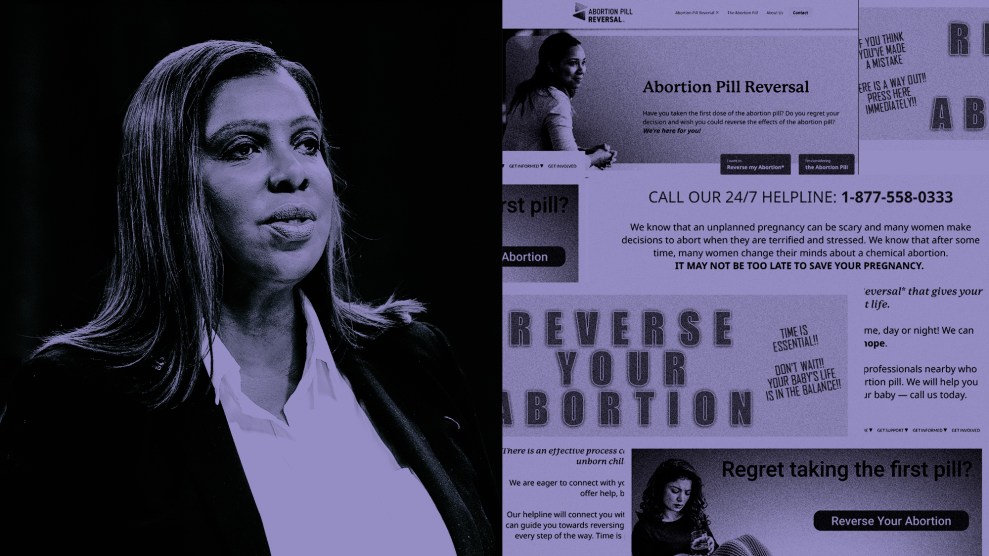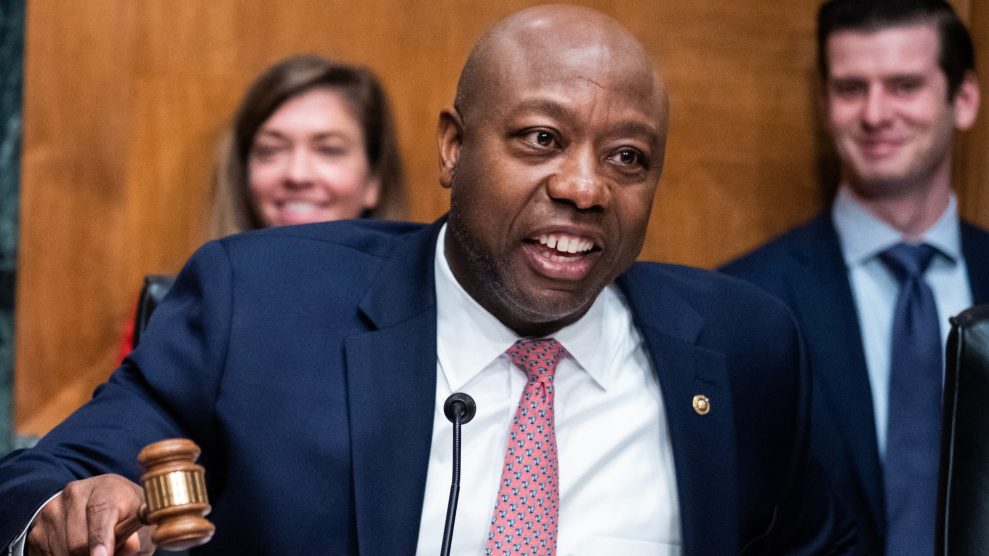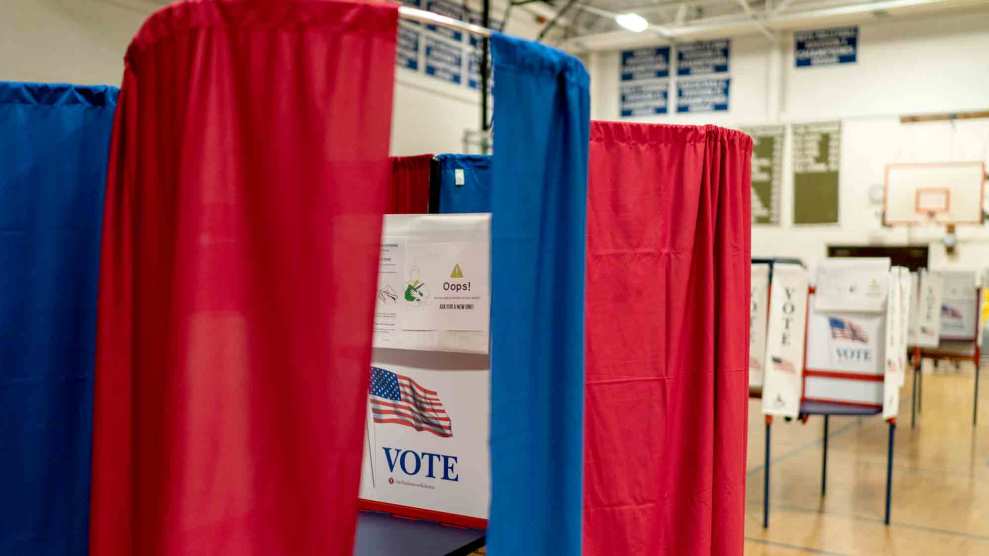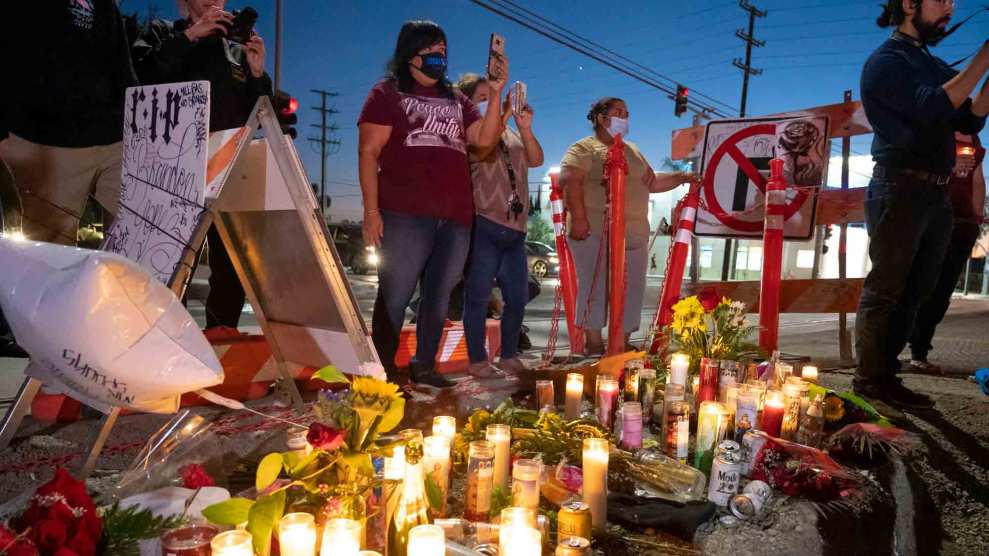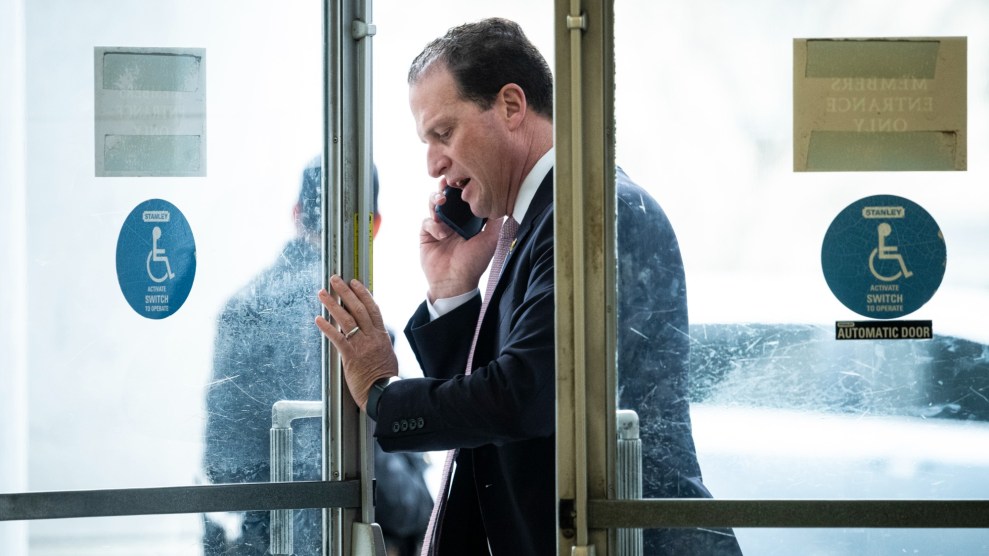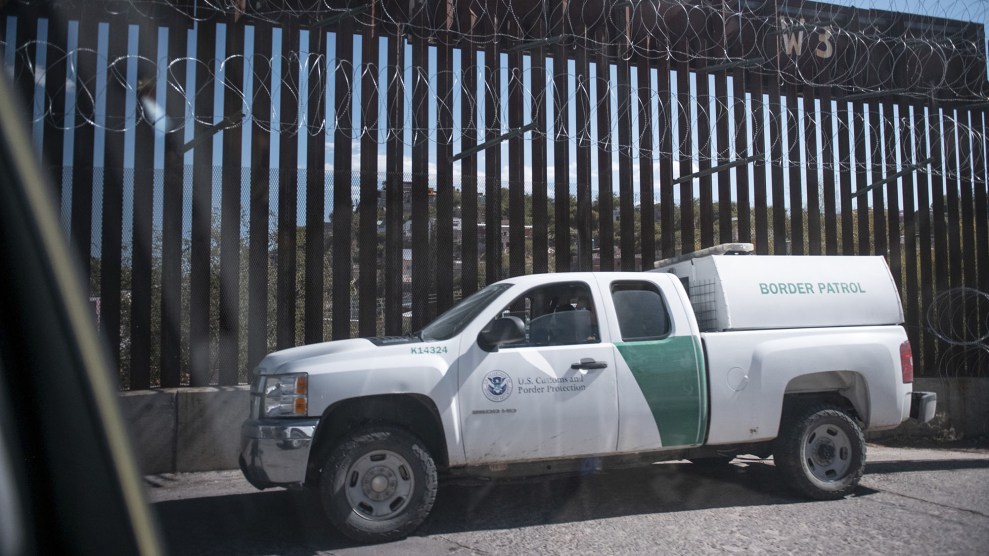
A Border Patrol vehicle along the Southern border.James K. Mccann/Zuma
This story was originally published by ProPublica.
It was late November 2017, and Matthew Bowen, a veteran Border Patrol agent, was seething. A fellow Border Patrol agent in Texas had just been found dead in the field, and Bowen was certain someone who’d been crossing the border illegally was responsible for murdering him.
“Snuffed out by some dirtbag,” Bowen, stationed in Nogales, Arizona, said in a text later obtained by federal authorities.
Bowen, if lacking in evidence, wasn’t alone in his anger and suspicion. President Donald Trump, nearing the end of his first year in office and already frustrated in his bid to construct a wall on the southern border, had promised to “seek out and bring to justice those responsible” for the Texas agent’s death. Brandon Judd, the head of the union that represents Border Patrol agents, declared to Fox News and other media outlets that the Texas agent had been “ambushed.”
Bowen’s work record suggested his distaste for the mix of migrants and drug traffickers crossing the border illegally could be dangerous. He’d been the subject of multiple internal investigations over excessive force during his 10-year career, court records show. In one, he’d been accused of giving a handcuffed suspect what agents called a “rough ride,” slamming the brakes on his all-terrain vehicle in a way that flung the suspect into the ground.
Bowen, though, had stayed on the job. And with the news of the Texas agent’s death, his disgust for illegal border-crossers seemed only to have deepened.
“Mindless murdering savages,” he texted to another agent that November.
Two weeks later, Bowen climbed behind the wheel of a Border Patrol pickup truck and used it to strike a Guatemalan migrant in a dusty parking lot in southern Arizona. Bowen eventually was arrested by federal authorities in May 2018 and charged with using his Ford F-150 pickup, a 4,000-pound vehicle, to menace the man as he tried to flee Bowen and other agents on foot. The truck, according to an affidavit filed by prosecutors in court, hit the man twice and came within inches of running him over. Prosecutors accused Bowen of using “deadly force against a person who was running away from him and posed no threat.”
On Monday, after months of legal wrangling and on the eve of trial, Bowen pleaded guilty to a single misdemeanor civil rights charge, an offense that carries a potential term of up to a year in jail. In his plea deal, Bowen admitted to hitting the man with his truck and promised to resign from the Border Patrol. Sentencing has been set for October.
Bowen’s arrest and a variety of his ugly texts concerning migrants and others crossing the border illegally have been widely reported in recent months. But court documents and interviews suggest that his checkered career speaks to a much broader problem in the Border Patrol: its inability or unwillingness to identify and discipline problem agents.
The case against Bowen comes amid increasing scrutiny of an agency that critics and insiders say is permeated by a culture of contempt for migrants. This year, ProPublica exposed the existence of a secret Facebook group in which agents engaged in cruel and dehumanizing discussions about people coming into the U.S. unlawfully. ProPublica has also detailed the failures by the agency to fully reform what critics inside and outside the Border Patrol have deemed a failed system of discipline for troubled agents.
Bowen’s attack on the Guatemalan migrant was at least the sixth time he had been accused of using excessive force during his decade with the agency.
None of the previous episodes resulted in any discipline beyond an “oral admonishment.” Unlike many police departments, the Border Patrol has no early intervention program for troubled agents, measures that would have triggered additional training or a deeper inquiry into Bowen’s behavior and mindset even if his conduct did not warrant formal discipline. At least two supervisors with direct knowledge of Bowen’s work history said they regarded him as a danger but were resigned to the fact that the agency was unlikely to ever punish or even fire him.
“Other law enforcement agencies would’ve weeded him out,” said one of those who supervised Bowen. “Other law enforcement agencies have much higher standards than we do.”
Bowen’s attorney, Sean Chapman, had sought to keep his record of complaints from being introduced at trial. The lawyer had also asked a judge to bar all or most of his text messages from being made known to any eventual jury. Faced with having to explain the texts, Chapman had said in court filings that the conversations were not unusual, but instead “commonplace” in the part of Arizona where Bowen worked. The texts, the lawyer argued in one filing last spring, are “part of the agency’s culture.”
If true, it’s a remarkable claim, for the messages Bowen traded over the years with colleagues are openly hateful. In one, he said the men, women and children attempting to cross into the U.S. were “disgusting subhuman shit unworthy of being kindling in a fire.” In another, he joked about how tasty Guatemalan migrants can be if they are properly “fried” through the use of Tasers. In yet another, Bowen trained his anger on his own agency, calling it a “fucking failed agency” where he and other agents “are treated like shit, prosecuted for doing what it takes to arrest these savages, and not given appropriate resources to fully do our job.”
In texts Bowen sent after he assaulted the migrant, he referred to the victim as a “guat” and dismissed the incident as all but a nonevent, suggesting the only reason it had resulted in any action was because it was caught on a camera belonging to the patrol’s parent organization, Customs and Border Protection.
With Bowen still awaiting sentencing, Chapman declined to speak in detail about the case or his client. However, the attorney insisted that the offensive messages “were in reference to specific events where Border Patrol agents were assaulted or killed. The texts therefore were not intended to be a general comment about illegal immigrants — only about individuals that attacked or injured agents.”
Officials with the Border Patrol and Customs and Border Protection would not respond to questions about Bowen’s case and what it might say about wider problems with the patrol.
In November 2017, enraged about the death of the agent in Texas, Bowen lamented that the border-crossers he suspected of killing the agent might spend years eluding the authorities.
“It will probably take them eight years to find the fucking beaners responsible,” he wrote in a text.
Months later, the FBI completed an exhaustive investigation into the Texas agent’s death. There was no evidence he’d been murdered. The local Texas sheriff said it appeared the agent, 36-year-old Rogelio Martinez, had fallen into a deep concrete culvert and suffered fatal head trauma.
“To date none of the more than 650 interviews completed, locations searched, or evidence collected and analyzed have produced evidence that would support the existence of a scuffle, altercation, or attack,” the bureau’s El Paso office said in a statement.
By then, Bowen had already committed the crime for which he’d pay with his career.
“I’ve Seen Egregious Incidents Get Swept Under the Rug”
Bowen — 6-foot-2, 185 pounds — joined the Border Patrol in 2008 just as it was undergoing the most substantial transformation in its history. With Congress boosting the Border Patrol’s funding, the agency underwent a massive hiring push, a surge that roughly doubled the number of agents in the span of just six years. Former officials now say the speed of the Border Patrol’s expansion made it likely there would be bad hires, perhaps a significant number of them.
Bowen, who had lived in South Carolina before joining the agency, was assigned to the Border Patrol station in Nogales, an outpost in the hill country of southern Arizona, where scrubby mesquite and paloverde trees stud the rugged landscape. The station, a fortresslike compound, stands about 2 miles from the U.S.-Mexico border, which is marked here by a rusty, 20-foot-tall steel fence encrusted with coils of razor wire. On one side of the barrier is the small town of Nogales, Arizona. On the other is the larger city of Nogales, in the state of Sonora, a major Mexican manufacturing hub that is home to more than 200,000 people.
The world of the Border Patrol is broken up into 20 geographic regions called sectors. The Nogales station is located in the Tucson sector, which covers about two-thirds of Arizona. While migration patterns and contraband routes are always evolving, the Tucson sector tends to be one of the busiest areas for Border Patrol agents. Agents in the sector made more than 52,000 arrests during the last fiscal year. Only the Rio Grande Valley sector in Texas had more apprehensions.
Over the years, the Tucson sector has also been known as a trouble spot within the patrol. In 2017, there were 701 disciplinary cases involving sector agents, more than anywhere else in the country.
In interviews, several people who worked with or supervised Bowen said he grew to have a reputation as a bully, a man with a bilious disdain for those seeking asylum or illegal entry into the U.S. In texts, Bowen referred to migrants and other border-crossers as “beaners” or “tonks,” a pejorative term referring to the sound made when agents banged their flashlights on the heads of those being taken into custody.
In later texts, he discussed his frustrations with the job and pondered quitting the patrol. A co-worker sent back a message reminding Bowen of the fun aspects of the job, like “running down shitbags who thought they had you fooled.”
From 2012 to 2015, five different people detained by Bowen accused him of needless violence, according to court records.
In January 2012, according to prosecutors, Bowen searched a young man’s car at a security checkpoint without probable cause. Bowen pulled the man from the car, threw him to the ground and handcuffed him. In March 2015, a fellow agent expressed concern after Bowen tackled a migrant and busted the man’s lip. A month later, an undocumented man said that Bowen had dragged him around by his handcuffs, causing painful abrasions to his wrists. In September 2015, Bowen was again reported by a colleague, this time for taking down a juvenile in a particularly violent fashion.
Later that fall, Bowen was accused of the “rough ride” incident. After apprehending an undocumented migrant in the desert, Bowen handcuffed him and threw him on the front of his ATV, according to court records and interviews. Then Bowen made the ride as unpleasant as possible, said a Border Patrol employee with direct knowledge of the incident. At one point, the employee said, Bowen purposely stomped on the brakes, causing the man, still handcuffed, to fly off the vehicle and slam into the dirt.
In these cases, Bowen was investigated by either Customs and Border Protection’s internal affairs bureau or by the Office of Inspector General with the Department of Homeland Security. Neither the internal affairs unit nor the Inspector General’s office responded to requests for comment.
Prosecutors sought permission to bring evidence of Bowen’s allegedly abusive behavior into the expected trial, arguing that the complaints helped to provide broader context for the truck attack. The defense attorney, Chapman, countered, saying in court briefs that the only relevant incident was the ATV episode, since it involved the use of a vehicle as a weapon.
Chapman, in court papers, maintained that Bowen had only been censured for two of the incidents, saying he’d received an “oral admonishment” after the episodes in March and April 2015. According to the attorney, Bowen was cleared of misconduct in the other three cases.
A current Border Patrol manager who worked with Bowen for many years said “oral admonishments are a joke” that do little to deter bad behavior.
The Border Patrol’s system for investigating and disciplining its agents has long been suspect, and in 2016, a blue-ribbon panel of experts named by then-President Barack Obama declared it nothing short of “broken.” Investigations dragged on for years, in part because there were too few investigators. Victims who accused agents of misconduct were largely kept in the dark, barred from knowing whether the accused agents had been found culpable and disciplined in any way. Scores of agents were arrested every year and charged with a wide variety of crimes, but many managed to hang onto their jobs.
One former Customs and Border Protection manager with extensive knowledge of the Border Patrol’s disciplinary process said the quality of casework was lacking and the end results of investigations inconsistent. The former official said the authority to discipline agents for on-the-job misconduct and policy violations generally rests with commanders in each of the agency’s 20 geographic sectors. Of the more than 700 discipline cases in the Tucson sector in 2017, more than 500 led to “informal discipline” or no punishment at all.
“I’ve seen egregious incidents get swept under the rug,” said the former Customs and Border Protection official, citing cases involving domestic violence and assault, embezzlement and lying to superiors.
Bowen’s lack of regard for any oversight at the agency comes through in the texts obtained by prosecutors. The discipline process, he suggested, is little more than a system for supervising officials to cover their rear ends. Customs and Border Protection employees who reported their co-workers for excessive force or other wrongs were “fags.”
“BP is just meant to destroy guys that want to catch people,” Bowen wrote in one text about his frustration with the agency.
One of the supervisors who managed Bowen said the Border Patrol’s disciplinary system is largely punitive and only responds, when it does at all, to one incident at a time. Many big city police departments, noted the supervisor, have created early intervention systems, which can track everything from uses of force to tardiness to public complaints in order to identify troubled officers and help them change course before something tragic occurs. Under such a system, the supervisor said, the pattern of complaints against Bowen could have prompted mandatory retraining or some kind of counseling. Either he would have improved or been squarely on the agency’s radar as a potential menace.
“It absolutely works,” the supervisor said of such early intervention systems.
“He Did Not Deserve to Be Executed”
At some point, records and interviews show, Bowen found another agent in Nogales with whom he felt a sense of kinship, Lonnie Swartz. They would come in the years ahead to share their perspectives on migrants and their dim view of their agency’s stomach for the hard work of ending illegal immigration. While joking darkly about their jobs, the two, records show, once had shared a three-minute video of a Border Patrol agent pummeling an undocumented man, repeatedly smashing his skull against the steel beams of a border fence.
“Please let us take the gloves off trump,” Bowen once wrote to Swartz in a text.
Bowen’s Border Patrol buddy, it turns out, probably never should have been hired. In 1995, he had enlisted in the U.S. Army and was stationed at Fort Knox, Kentucky. But, within weeks, he had gone AWOL and fled the base. Facing criminal charges under military law, Swartz lived on the lam for nearly two years before he was captured in Las Vegas by a joint task force of local police officers and FBI agents, federal court records indicate. He was eventually ousted from the Army with an “other than honorable” discharge.
Somehow, however, he made it through the agency’s background check process and was hired by the Border Patrol in 2009, a year after Bowen. Court records indicate that Swartz misled the background investigators about his violations of military law during the hiring process in 2009 and again during a second background check in 2014. The former Customs and Border Protection official said that the Army discharge issue should have kept Swartz out of the patrol.
“That’s just shoddy,” the person said. “That should be an automatic disqualification. Whoever did the background investigation didn’t do their job properly.”
Chapman, who specializes in cases involving Border Patrol agents, represented Swartz during his trials. In an email, the attorney said Swartz “didn’t attempt to mislead anyone” about his history with the Army.
A spokesperson for Customs and Border Protection would not comment on the circumstances surrounding Swartz’s hiring.
In 2012, about two years after graduating from the Border Patrol academy, Swartz was the one facing federal criminal charges. Swartz had shot and killed a 16-year-old boy, José Antonio Elena Rodríguez, during what he and other agents said was a dangerous encounter with rock-throwing Mexican nationals along the border fence. Charging Swartz with murder, federal prosecutors told a very different story. They said that in reality Swartz was in no danger of being struck by a stone when he opened fire and shot the teen 10 times — two bullets hit the youth in the head, the others in the back. Rather, the prosecutors argued, Swartz killed the boy because he was “fed up” after a series of clashes with migrants and other border-crossers.
Whether or not the boy was throwing rocks that night, prosecutors said, “it wasn’t a capital offense. He did not deserve to be executed.”
The shooting prompted a long and unusual series of events. For three years, the Border Patrol would not make public the name of the agent who had shot the boy, including to the boy’s family. It was only after the family filed suit against the agency that the federal authorities brought criminal charges against Swartz. His first trial ended with a jury acquitting him of murder charges but deadlocking on the lesser offense of manslaughter. The second, coming near the end of 2018, resulted in Swartz’s acquittal on all charges. The second jury had repeatedly told the judge it was unable to reach a unanimous verdict, and it only wound up acquitting when the judge ordered the jurors to keep trying.
Swartz’s lawyer argued at the trials that Swartz had followed proper procedure in firing his weapon.
“You can employ deadly force against a rock thrower if he poses a risk of serious bodily harm. That’s the law,” said Chapman during the second trial. “And that’s what he did. He followed his training and he followed the law.”
But a high-ranking Border Patrol agent who served in Nogales said that Swartz was a management challenge from the start of his tenure with the patrol. “He was too aggressive” and was constantly looking to escalate encounters with smugglers or migrants at the border fence, the agent said. Supervisors, said the agent, tried unsuccessfully “to reel him in.”
Disturbed by the teen’s killing — and a raft of other cross-border shootings — Customs and Border Protection leaders in 2013 brought in a team of outside law enforcement experts to examine the Border Patrol’s guidelines regarding the use of firearms. “Frustration is a factor motivating agents to shoot at rock throwers,” found the analysts, who studied 67 shooting incidents and 10 key policy directives. “While rock throwing can result in injuries or death, there must be clear justification to warrant the use of deadly force.”
The report, produced by the Police Executive Research Forum, a Washington, D.C.-based consultancy, was followed by a four-page update to the use-of-force policies. Under the new rules, agents who were attacked with rocks or other projectiles were supposed to seek cover and “distance themselves from the immediate area of danger.”
The change left many agents grumbling that the Border Patrol had gone soft.
The Border Patrol would not say if Swartz still works for the agency in any capacity.
“It Just Seems to Keep Getting Worse”
Around 7:30 one morning in December 2017, a 23-year-old Guatemalan national named Antolín López-Aguilar slipped over the border fence in Nogales and tried to hide underneath a parked semi-trailer.
Bowen, who was driving a green-and-white patrol-issued truck, was sent to apprehend the migrant. He was accompanied by two other agents who had been dispatched in separate vehicles.
When López-Aguilar tried to run, Bowen, still in his truck, gave chase. According to prosecutors, Bowen then made the conscious decision to drive his F-150 pickup into the migrant, striking the man twice from behind and pushing him to the ground. The attack, which prosecutors said left López-Aguilar mildly injured and traumatized, was captured by video cameras at a nearby port of entry.
In the days and weeks after the assault, texts obtained by the government show, Bowen appeared both proud of his conduct and confident that little would come of it. In a text to Swartz, Bowen boasted of having performed what he called “a human pit maneuver.” PIT stands for pursuit intervention tactic. In simple terms it involves a police officer or law enforcement agent driving his or her car into the rear of a fleeing vehicle. There is no such thing in American policing as a “human pit maneuver.”
“The tonk was totally fine,” Bowen wrote, using the crude term again. “Just a little bump with a ford bumper.”
“If I had to tackle the tonk,” he said in another message, “I would still be doing memos and shit.”
In his text conversations, Bowen complained that he was only being investigated because the incident had been captured by the video cameras. He acknowledged that he’s been on the “radar” of the internal affairs bureau and seemed to have wearied of the agency’s efforts, however modest, to police its own.
“I’ve decided after this is cleared up, I’m resigning,” he wrote.
It did not get cleared up, and Bowen’s texts reveal his growing anxiety. He noted that he could be charged with assault with a deadly weapon. He feared being sent away from his family. For comfort, he reached out to Swartz, who at the time was still in the midst of his prosecution for the boy’s shooting.
“Guys are being made to think any use of force results in you being investigated,” Bowen wrote to Swartz. “And so they are letting tonks get away with way too much.”
The array of texts obtained by the government, whatever significance they have for Bowen’s crime or the Border Patrol’s oversight of him, do offer a very personal and specific window into the mindset and apparent morale problems that current and former agents say plague the agency.
Bowen derided the “liberal” media and Obama appointees, and he thought in the current political environment, prosecutors were determined to make criminal prosecutions out of virtually any use-of-force case that gets referred to them. He was bitter, he said, about how the system was “rigged” just as Trump claimed, although it’s unclear what system he was talking about. Swartz seemed sympathetic. In one text to Bowen, he complained about how the agency was under-funded, and its equipment was unreliable, even its weapons.
Bowen made clear in his texts that he no longer believed in his own agency, and that he had been contemplating bailing from the Border Patrol for a long time. He’d explored taking classes that might help him get into the real estate business — his wife was a real estate agent — or starting a trucking company. He’s done with his “mindless” job.
“I just have to transition away from BP,” wrote Bowen. “I think it will be like coming out of a 10-year depression.”
He continued, “There were lots of good days. But the past few years the bad has far outweighed the good and it just seems to keep getting worse.”
In a text from Dec. 8, 2017, just days after the incident with the truck, Bowen wrote without irony: “This shit is the kicker I needed to make the decision,” he said of resigning. “I feel like one day I would have to make a decision that would cost me my life or my freedom.”
Filed under:
